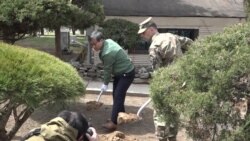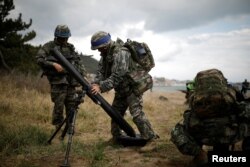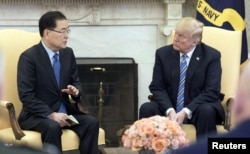The annual U.S.–South Korea joint military exercises currently underway have historically been a very public demonstration of force intended, in part, to counter North Korea’s aggressive nuclear and missile tests. But with looming diplomatic summits aimed at reaching a deal to end the North’s nuclear program, media coverage of the drills has so far been limited.
This week, the U.S. Second Infantry Division held a public tree planting ceremony at Camp Casey in South Korea, near the inter-Korean border.
WATCH: US-South Korea relations
“It is my belief that this tree, like those that have come before it, shall symbolize the roots that bind us together, and to our past in an enduring way,” said General Jon Howerton, the deputy commander of the U.S. 2nd Infantry Division, at the event.
The journalists attending the tree ceremony were also permitted to watch a shooting competition to determine the best marksmen in the participating U.S. and South Korean divisions.
Restricted coverage
The Camp Casey event was one of the few joint military training activities that news organizations have, so far, been allowed to cover, and it illustrates how the United States and South Korea are downplaying the offensive component of this year’s combined exercises.
“This is clearly in order to send a signal to North Korea that South Korea and the United States are not willing to escalate the situation any further,” said Go Myong-Hyun, a North Korea analyst with the Asan Institute for Policy Studies in Seoul.
This year’s Foal Eagle and Key Resolve combined military exercises are similar in scale to past drills, with more than 23,000 U.S. troops and 300,000 South Korean forces engaging in joint battlefield maneuvers, and responding to computer-simulated attacks from North Korea.
But the start of the drills was delayed this year at South Korea’s request to set a peaceful tone for the Pyeongchang Winter Olympics in the South and to facilitate the North’s participation in the games.
In the past few years the joint exercises were held at times of heightened tensions as North Korea conducted increasingly threatening ballistic missile and nuclear tests. The United States, in response, had prominently featured nuclear capable aircraft carriers, bombers and other offensive weaponry to demonstrate the ability to respond with overwhelming force to a North Korean attack.
But these nuclear capable military assets are not expected to participate this year as the Olympic outreach helped bring about a pause in Pyongyang’s provocative tests, and has led to diplomatic progress toward denuclearization talks.
In the past North Korea objected to the U.S.-South Korea exercises as “rehearsals for invasion.” But North Korean leader Kim Jong Un dropped his objection to the drills as part of his recent diplomatic outreach.
Diplomatic focus
Planning is underway for the North Korean leader and South Korean President Moon Jae-in to meet at the end of April, and for a U.S.-North Korea summit.
U.S. President Donald Trump this week confirmed his administration is in contact with Pyongyang and expects to meet with Kim in late May or early June.
“I think there will be great respect paid by both parties and hopefully we'll be able to make a deal on the de-nuking (denuclearization) of North Korea,” said President Trump.
And the North Korean leader this week publicly acknowledged the upcoming summits for the first time at a meeting of the ruling Workers' Party of Korea. KCNA, the North's central news agency, reported that Kim “set forth the strategic and tactical issues” that will be the focus of the upcoming talks with Washington and with Seoul.
The communications between the United States and North Korea are at a preliminary stage and have been conducted mostly through their United Nations missions and intelligence officers from both sides.
It remains unclear if Pyongyang is willing to commit to the complete dismantlement of its nuclear arsenal in return for ending tough international sanctions that ban most of the North’s exports, and for providing other assistance and security guarantees as well.
So as not to disrupt the diplomatic initiatives underway, the joint military drills are, so far, keeping a low profile.
Lee Yoon-jee in Seoul contributed to this report.











